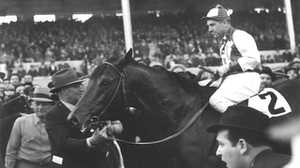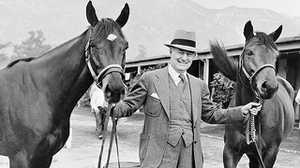The East-West Rivalry
In the late 1930s, the spirited debate over whether Seabiscuit or War Admiral was the greater horse was also a battle between the era’s dominant Eastern racing establishment and the upstart Western one.

Eastern Bias
At the time, the authoritative figure in Eastern racing circles was War Admiral’s sour owner, Samuel Riddle, known as much for his misanthropic demeanor as his success with horses. Riddle had dominated the racing world ever since he’d bought a big, yearling colt named Man o'War in 1918 for the bargain price of $5,000. Man o’ War not only became one of the greatest Thoroughbreds ever, but also paid dividends as the sire of a barn-full of other renowned Thoroughbreds, including War Admiral. Riddle, conservative even by Eastern standards, ran his Man o’ War in only 21 races — the horse won 20 times. He kept his colt out of the Kentucky Derby in part because of his low opinion of any racing conducted farther west than New York.
The Hundred-Grander
Members of the western Thoroughbred community made the Eastern establishment take notice when they built the magnificent Santa Anita Park outside of Los Angeles in 1934, lavishing $3 million on its construction during the lean Depression years, with a good chunk of the investment coming from the singer Bing Crosby and Seabiscuit’s future owner, Charles Howard. The track’s signature event, the Santa Anita Handicap, offered the staggering winner-take-all prize of $100,000. Race fans began referring to the immediate classic as the “hundred-grander.”
Seabiscuit’s Campaign
One race and one racetrack, though, did not convince Easterners that a challenger to their supremacy had arrived. That only happened in 1937, when Howard barnstormed Seabiscuit on an 8,000 mile cross-country racing campaign to prove that his horse was as good as any the East could offer. “Seabiscuit will take on all comers,” the car tycoon had told the press, “and he’ll mow them down like grass.” During that stretch, eastern racing snobs lost a good share of their wagers as Howard’s Thoroughbred won ten major stakes races, including the Brooklyn Handicap, the Yonkers Handicap and the Massachusetts Handicap. Still, “the Eastern people would sneer 'Oh, he’s a California horse,’ and for many years they were right,” says sportscaster Jack Whitaker, “because it was the Eastern horses cleaning up on the Triple Crown races anyway.”
Seeking a Showdown
When Westerners argued that Western racing, led by Seabiscuit, had come of age, Easterners trumped the claim by uttering the name of the best Eastern horse: War Admiral. Howard hustled hard for a showdown between Seabiscuit and War Admiral but the 75-year-old Riddle, conservative as ever, felt lukewarm about a two-horse contest. The Eastern kingpin told reporters that he had no interest in demeaning his horse’s reputation in a contest against a Western colt. After several match-ups between the horses fell through, Alfred Vanderbilt, the twenty-six-year-old manager of Baltimore’s Pimlico Racecourse, finally convinced Riddle to run War Admiral against his competitor on November 1, 1938.
Western Success
The unlikely California champion might have seemed a poor prospect next to a horse as imposing as War Admiral, but when Seabiscuit raced that day, he catapulted to the lead. War Admiral, challenged more than in any other race in his life, ran his fastest time ever for the 1 3/16-mile distance. Yet Seabiscuit won by four lengths. Red Pollard, the injured jockey who usually rode Seabiscuit, said of the horse, “He did just what I’d thought he’d do. He made a rear admiral out of War Admiral.” Whether Easterners liked it or not, the Western racing establishment, riding on Seabiscuit’s back, had arrived.







